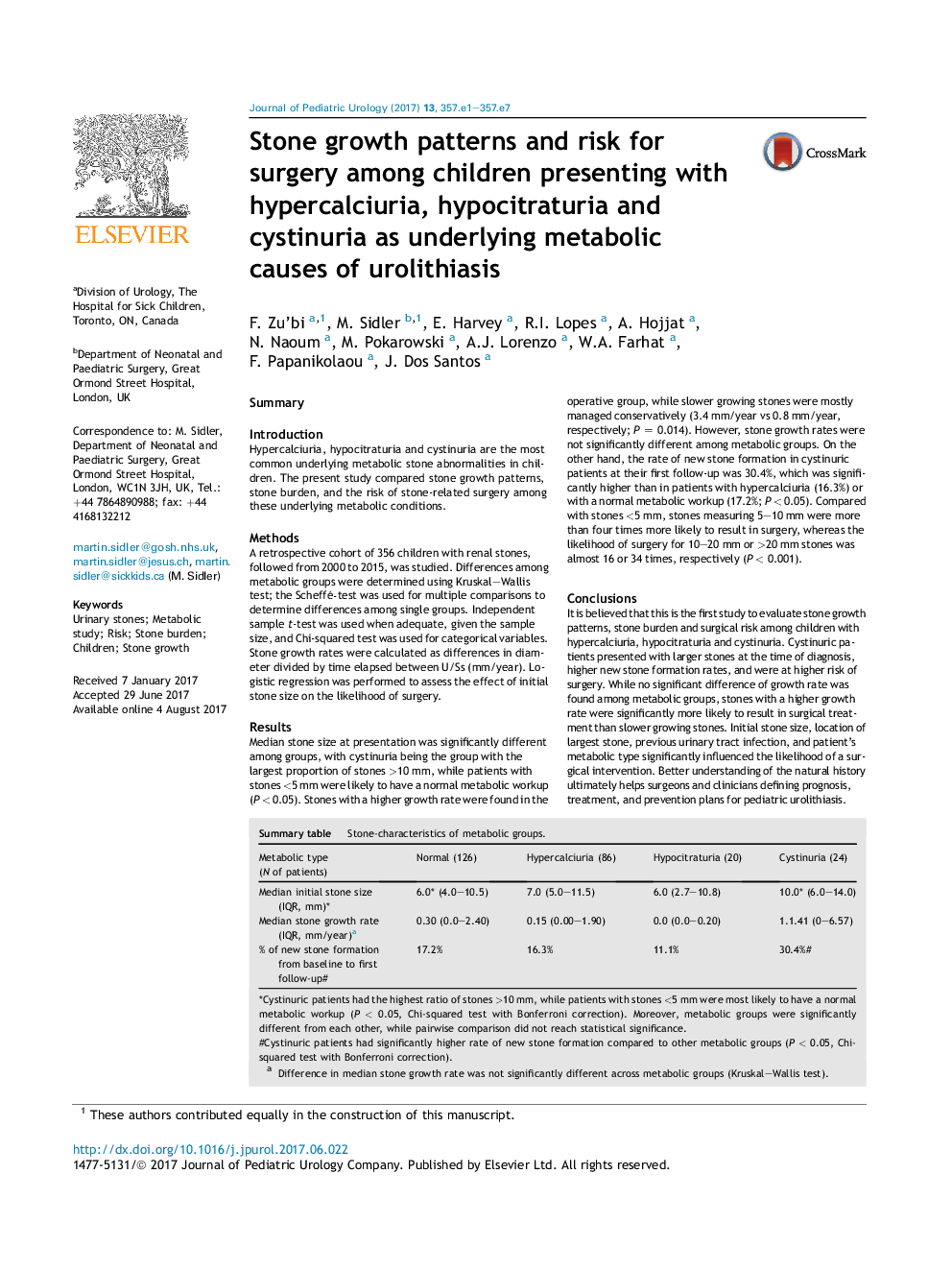| کد مقاله | کد نشریه | سال انتشار | مقاله انگلیسی | نسخه تمام متن |
|---|---|---|---|---|
| 5718540 | 1607135 | 2017 | 7 صفحه PDF | دانلود رایگان |
SummaryIntroductionHypercalciuria, hypocitraturia and cystinuria are the most common underlying metabolic stone abnormalities in children. The present study compared stone growth patterns, stone burden, and the risk of stone-related surgery among these underlying metabolic conditions.MethodsA retrospective cohort of 356 children with renal stones, followed from 2000 to 2015, was studied. Differences among metabolic groups were determined using Kruskal-Wallis test; the Scheffé-test was used for multiple comparisons to determine differences among single groups. Independent sample t-test was used when adequate, given the sample size, and Chi-squared test was used for categorical variables. Stone growth rates were calculated as differences in diameter divided by time elapsed between U/Ss (mm/year). Logistic regression was performed to assess the effect of initial stone size on the likelihood of surgery.ResultsMedian stone size at presentation was significantly different among groups, with cystinuria being the group with the largest proportion of stones >10Â mm, while patients with stones <5Â mm were likely to have a normal metabolic workup (PÂ <Â 0.05). Stones with a higher growth rate were found in the operative group, while slower growing stones were mostly managed conservatively (3.4Â mm/year vs 0.8Â mm/year, respectively; PÂ =Â 0.014). However, stone growth rates were not significantly different among metabolic groups. On the other hand, the rate of new stone formation in cystinuric patients at their first follow-up was 30.4%, which was significantly higher than in patients with hypercalciuria (16.3%) or with a normal metabolic workup (17.2%; PÂ <Â 0.05). Compared with stones <5Â mm, stones measuring 5-10Â mm were more than four times more likely to result in surgery, whereas the likelihood of surgery for 10-20Â mm or >20Â mm stones was almost 16 or 34 times, respectively (PÂ <Â 0.001).ConclusionsIt is believed that this is the first study to evaluate stone growth patterns, stone burden and surgical risk among children with hypercalciuria, hypocitraturia and cystinuria. Cystinuric patients presented with larger stones at the time of diagnosis, higher new stone formation rates, and were at higher risk of surgery. While no significant difference of growth rate was found among metabolic groups, stones with a higher growth rate were significantly more likely to result in surgical treatment than slower growing stones. Initial stone size, location of largest stone, previous urinary tract infection, and patient's metabolic type significantly influenced the likelihood of a surgical intervention. Better understanding of the natural history ultimately helps surgeons and clinicians defining prognosis, treatment, and prevention plans for pediatric urolithiasis.Summary table. Stone-characteristics of metabolic groups.Metabolic type (N of patients)Normal (126)Hypercalciuria (86)Hypocitraturia (20)Cystinuria (24)Median initial stone size (IQR, mm)*6.0* (4.0-10.5)7.0 (5.0-11.5)6.0 (2.7-10.8)10.0* (6.0-14.0)Median stone growth rate (IQR, mm/year)a0.30 (0.0-2.40)0.15 (0.00-1.90)0.0 (0.0-0.20)1.1.41 (0-6.57)% of new stone formation from baseline to first follow-up#17.2%16.3%11.1%30.4%#*Cystinuric patients had the highest ratio of stones >10Â mm, while patients with stones <5Â mm were most likely to have a normal metabolic workup (PÂ <Â 0.05, Chi-squared test with Bonferroni correction). Moreover, metabolic groups were significantly different from each other, while pairwise comparison did not reach statistical significance.#Cystinuric patients had significantly higher rate of new stone formation compared to other metabolic groups (PÂ <Â 0.05, Chi-squared test with Bonferroni correction).aDifference in median stone growth rate was not significantly different across metabolic groups (Kruskal-Wallis test).
Journal: Journal of Pediatric Urology - Volume 13, Issue 4, August 2017, Pages 357.e1-357.e7
